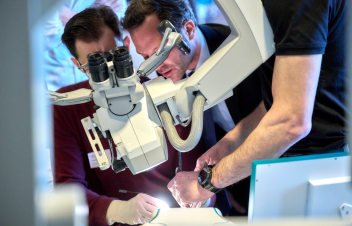What Are the Success Rates of Aneurysm Coiling?
- surgeonslab1
- Mar 7
- 4 min read

Aneurysm coiling has become one of the most common ways to treat brain aneurysms. Platinum coils are placed into the aneurysm sac in this minimally invasive operation to induce thrombosis, therefore preventing rupture or rebleeding. But what are the actual success rates of aneurysm coiling, and how do they differ from other treatments?
Understanding Aneurysm Coiling
Aneurysm coiling, also known as coil embolization, is performed by guiding a microcatheter through the vascular system—usually starting at the femoral artery—to the aneurysm site. Once in place, coils are deployed to fill the aneurysm, which helps to disrupt blood flow and induce clot formation within the sac. Clinically, success is typically measured in terms of:
Immediate Occlusion: The rate at which the aneurysm is adequately sealed off during the procedure.
Long-term Durability: The ability to maintain occlusion over months to years, reducing the risk of recurrence.
Clinical Outcomes: Rates of complications, rebleeding, and retreatment.
Immediate Occlusion and Technical Success
Recent studies and meta-analyses have reported that immediate adequate occlusion after aneurysm coiling is achieved in approximately 90%–91% of cases. This means that during the procedure, nearly all treated aneurysms show minimal to no residual filling, indicating a high initial technical success. The high packing density and the use of adjunctive techniques—such as balloon-assisted or stent-assisted coiling—can further increase these success rates, especially in complex aneurysms with wide necks.
Key Points:
Technical success rate: ~90%–91% immediate occlusion.
Adjunctive techniques: Increase occlusion rates in challenging aneurysm geometries.
Procedure-related complications: They vary by aneurysm size, location, and operator expertise but are usually modest.
Long-term Durability and Recurrence Rates
While immediate occlusion rates are promising, long-term durability remains a key concern. Follow-up studies have indicated that recurrence rates may vary from 20% to as high as 33% in some cohorts—particularly for larger aneurysms or those with wide necks. Recurrence typically occurs due to coil compaction or aneurysm regrowth. However, the need for retreatment tends to be lower, around 5%–10%, as many recurrences remain clinically insignificant or stable on serial imaging.
Factors Influencing Long-term Success:
Aneurysm Size: Larger aneurysms tend to have higher recurrence rates.
Aneurysm Location: Aneurysms in the posterior circulation are more challenging and more likely to recur.
Coil Packing Density: Recurrence can be reduced by increasing packing density.
Follow-Up Protocols: Regular imaging follow-ups (using DSA, MRA, or CTA) are crucial for early detection of recanalization, allowing for timely retreatment if needed.
In terms of long-term outcomes, several studies have demonstrated that the overall “success” of aneurysm coiling—when considering both immediate and durable occlusion, along with favorable clinical outcomes—ranges between 80% and 85%. This means that for the majority of patients, endovascular coiling offers a durable solution with a low risk of rebleeding.
Clinical Outcomes and Comparative Effectiveness
A landmark study, the International Subarachnoid Aneurysm Trial (ISAT), compared endovascular coiling with surgical clipping in patients with ruptured aneurysms. ISAT and subsequent follow-up studies found that while coiling had a higher rate of aneurysm recurrence than clipping, it also resulted in lower immediate morbidity and mortality rates. Coiling reduces hospital stays and recovery time due to its minimal invasiveness.
Comparative Insights:
Endovascular Coiling: Lower initial morbidity and mortality; faster recovery; higher recurrence rate that may require retreatment.
Surgical Clipping: More invasive with higher upfront risk; generally lower recurrence rates over the long term.
Patient Selection: Optimal for patients with smaller, saccular aneurysms with narrow necks; in complex cases, adjunctive devices can improve outcomes.
Minimizing Recurrence: Innovations in Technology
Advances in endovascular devices and techniques are continuously improving the success rates of aneurysm coiling. Innovations such as bioactive coils (e.g., Matrix coils) and flow-diverter stents have been developed to enhance aneurysm occlusion and reduce recanalization. These technologies work by not only mechanically filling the aneurysm but also promoting a biological healing response along the aneurysm wall.
Future Trends:
Hybrid Techniques: Combining coiling with flow diversion in selected cases.
Improved Coil Designs: New materials and coatings that reduce coil compaction.
Enhanced Imaging: Better real-time imaging allows more precise coil deployment during the procedure.
The Role of Simulation in Training and Preoperative Planning
Because coiling an aneurysm is so complicated and accuracy is so important, neurosurgeons can't do their jobs without modeling technology. Leading medical simulation company SurgeonsLab has created a cutting-edge simulator model that lets professionals practice aneurysm coiling operations in risk-free surroundings. With patient-specific models provided by this creative platform, surgeons can experience realistic hemodynamics and tactile feedback of actual aneurysm coiling.
SurgeonsLab’s simulator model not only helps in refining technical skills but also in preoperative planning, making sure every treatment is catered to the particular anatomy and pathology of the patient. Advanced training programs of this kind have been demonstrated to cut procedure times, lower problems, and eventually help to increase long-term success rates.
Key Takeaway
Aneurysm coiling is a highly effective endovascular treatment with immediate technical success rates of around 90% and long-term success rates of 80%–85% when accounting for recurrence and clinical outcomes. Although recurrence remains a concern—particularly in larger or wide-neck aneurysms—the overall clinical outcomes, lower morbidity, and faster recovery times make coiling an attractive option compared to surgical clipping. Ongoing innovations in coil technology and the use of adjunctive devices continue to improve the durability of the procedure.
Furthermore, the simulator model developed by Surgeons Lab is transforming surgical education and preoperative preparation. Such simulators assist in guaranteeing that every coiling operation is maximized for success by allowing neurosurgeons to practice in a very realistic, patient-specific environment, therefore improving patient outcomes and safety.
In summary, while no treatment is without risk, the evolution of endovascular coiling—supported by innovations in technology and training—provides a robust, minimally invasive solution for the management of cerebral aneurysms.







